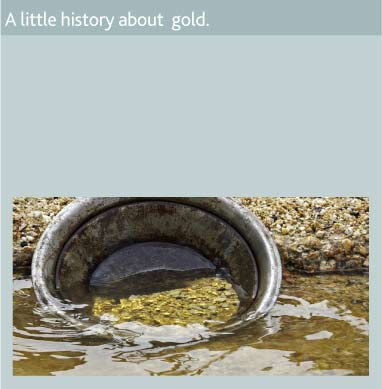
Gold Basics - Gold 101
There is more to gold than just its shiny yellow hue. Gold is actually a chemical element. There are 117 known chemical elements on Earth. Of these, 92, including gold, occur naturally. Gold has stable isotopes, which means it does not experience any radioactive decay. Gold’s symbol on the periodic table is Au. This comes from the Latin word for gold, aurum. Across the globe, the Aztecs who were also fascinated by gold called the precious metal teocuitlatl. In their language this meant excrement of the gods. As a chemical element, gold is also identified by its atomic number—79. The atomic number indicates the number of protons located in the nucleus of an element’s atom. This information is important to chemists and physicists.
You may think of gold as it is used in jewelry or coins, but its natural state is much different. Gold is most commonly found as nuggets or grains. It occurs naturally in rocks and veins. Often it gets washed into streams and riverbeds. Because gold has been considered valuable since its discovery, much of it has been recycled. In fact, it is believed that more than 85 percent of the gold ever found we are still using today.
In addition to being a chemical element, gold is a precious metal. It is shiny and known for its bright color. Of the metals, it is the most malleable. When a metal is malleable that means it can be formed into a thin sheet through hammering or rolling. Gold is also the most ductile metal. This means that it can be stretched into a thin wire. Many metals are either malleable or ductile, but not both.
Throughout time gold has been sought after as an adornment and as a monetary unit. In addition, today gold is used in a variety of industries, including health care and electronics. One example of gold’s use in health care is as an anti-inflammatory for people suffering from rheumatoid arthritis. Injections of a liquid suspension of gold have been a common treatment for more than 70 years, although doctors are not sure why gold helps in this form.
Next: Gold Characteristics
Sell Gold at BrokenGold™! It's easy, just put your gold in the prepaid envelope and send it to us. You will receive a check 24 hours after we receive your gold. It is that easy! We have gained an excellent reputation on the web and have an ever-growing list of satisfied customers. If you have questions take a look at our Frequently Asked Questions page.
Back to the Gold 101

Gold was first discovered thousands of years ago in its natural state, in streams, which lead to mining all over the world. Its brilliance, natural beauty, great malleability and resistance to tarnish made it enjoyable to work with. Gold gave rise to the concept of money itself. Today gold is used for jewelry fabrication, industrial application, and medical uses, by governments and central banks and by private investors.



Sell scrap gold, silver and have more cash for gold jewelry.
To get started selling gold, fill out the form below.
 |  |
We are a proud member of TRUSTe, Gemological Institute of America, International Precious Metals Institute.

